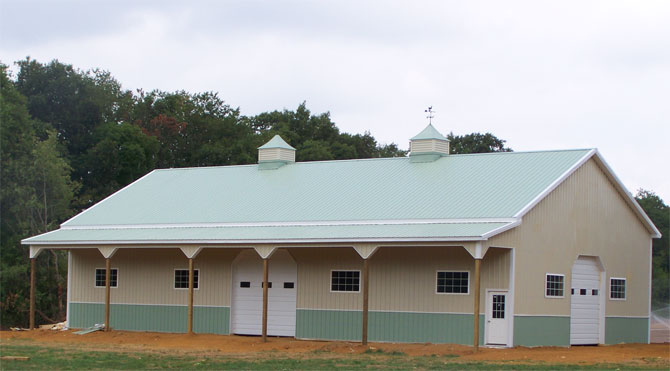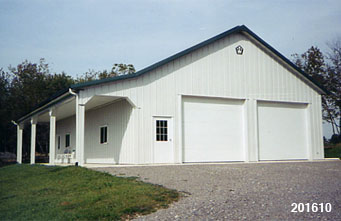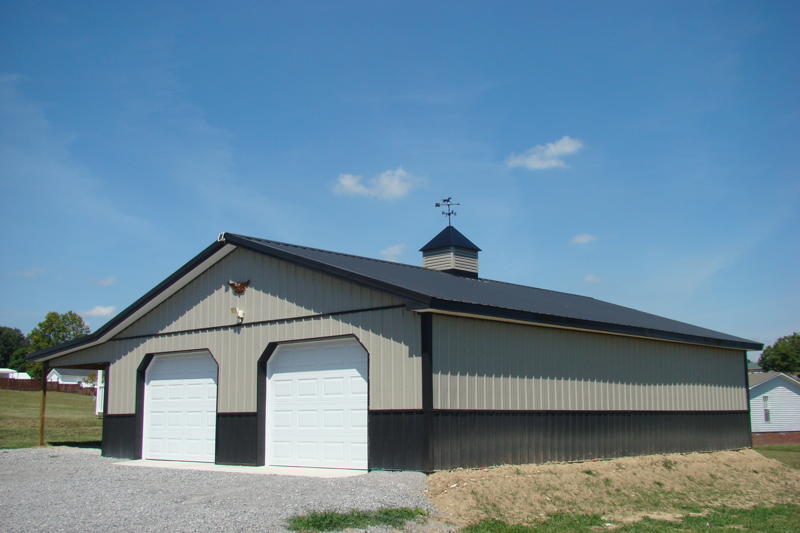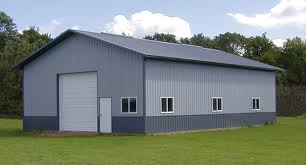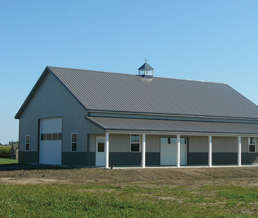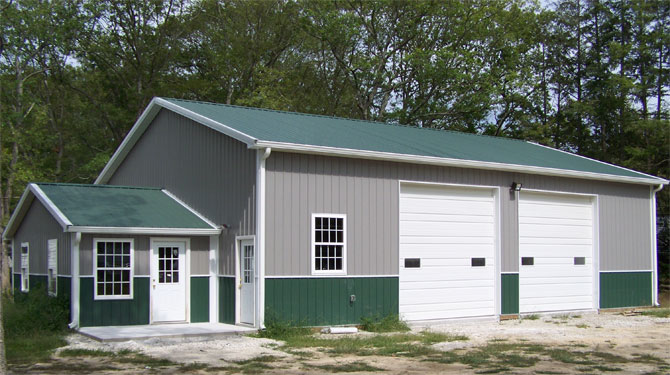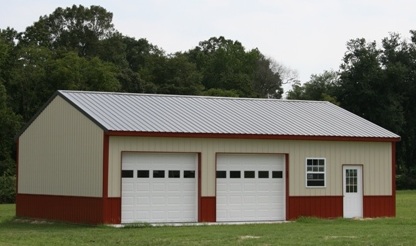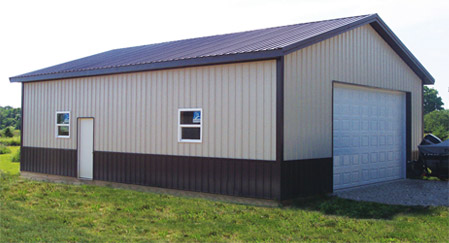US Metal Garages
Pole Barn Kits California | Pole Buildings California CA
We now carry California CA pole barn kits. We carry California CA pole buildings in many different sizes. Our metal pole barns come standard with 14 ga framing with available 12 gauge at an additional cost! Also our sheet metal comes standard with 29 gauge with 26 gauge available at an additional cost. Our sheeting is available in 13 different colors. Our California CA pole barns are great for agricultural, commercial and livestock! Our all toll free 1-877-662-9060 for more information!
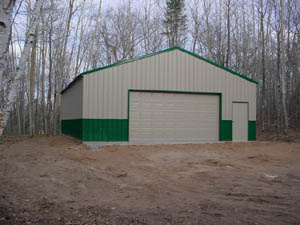
Call toll free: 1-877-662-9060
Email us: sales@mayberrymetalstructures.com
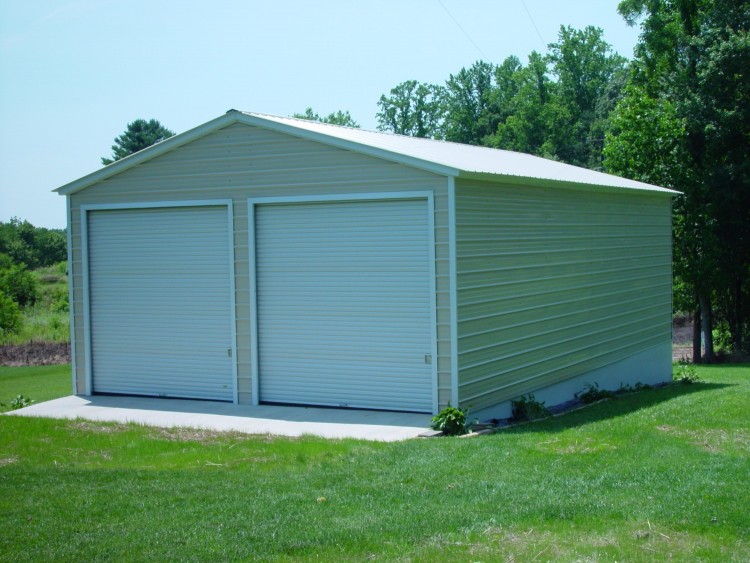
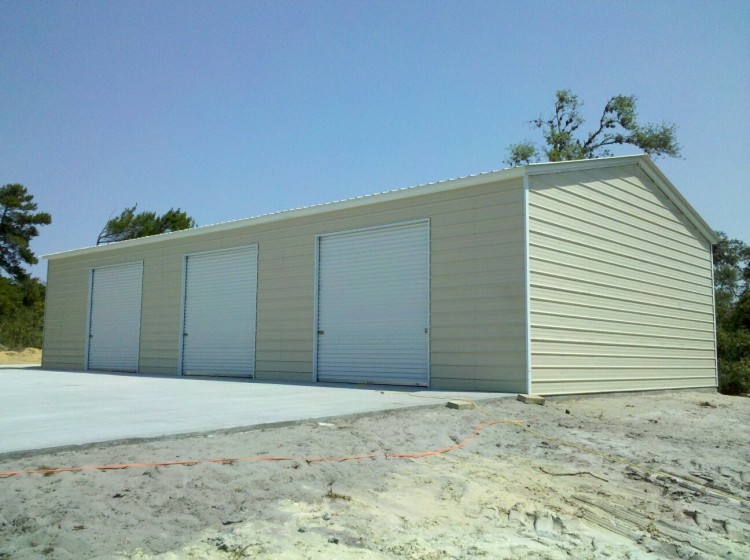
24x40x11 Vertical Roof Garage
With: (3) 10'x10' Garage Doors
(1) 36"x80" Walk in Door
24x30x11 Vertical Roof Garage
With: (2) 10'x10' Garage Doors
(1) 36" Walk in Door
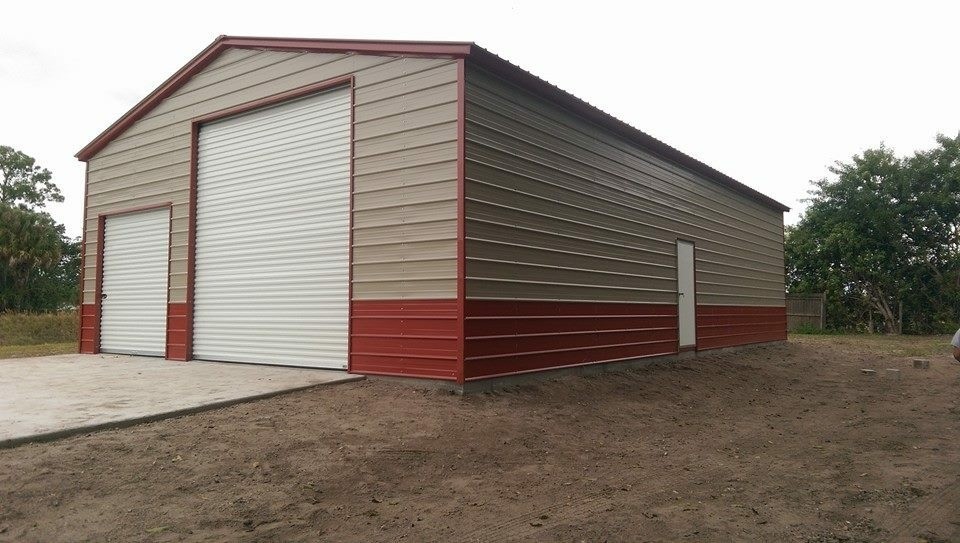
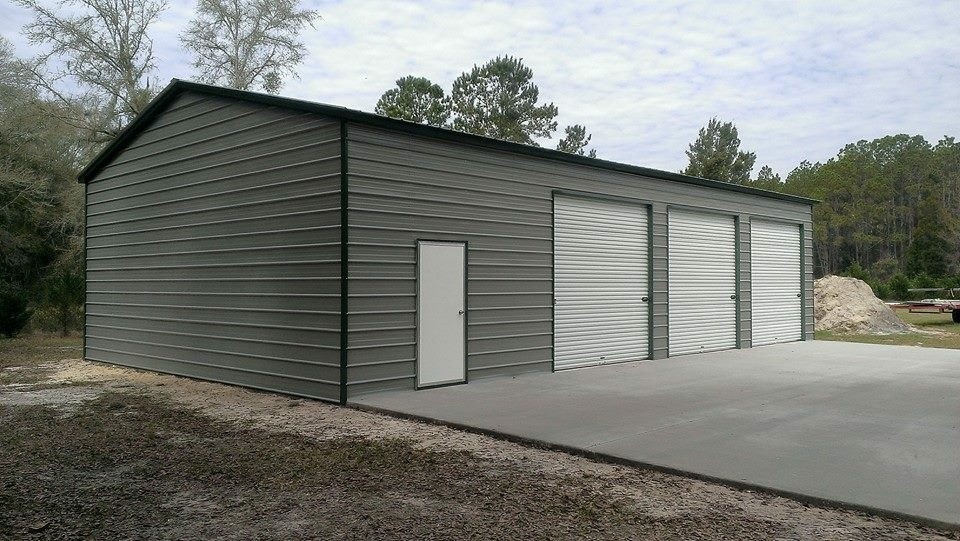
1-877-662-9060
24x45x12 Vertical Roof Garage
with: (3) 10'x10' Garage Doors
(1) 36" Walk in Door
24x40x12 Vertical Roof Garage
with: (1) 10'x10' Garage Door
(1) 6'x6' Garage Door
(1) 36" Walk in Door
1-877-662-9060
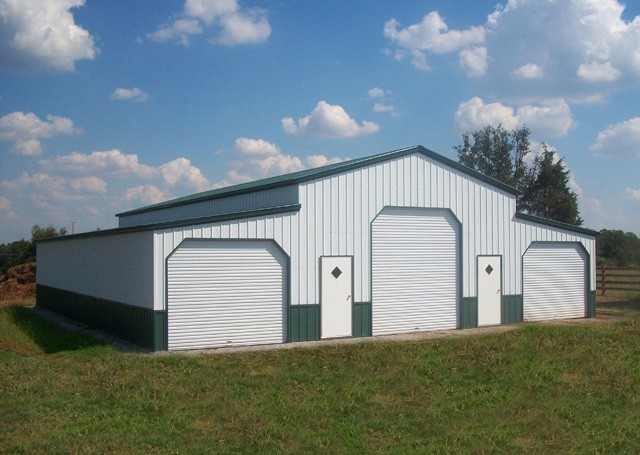
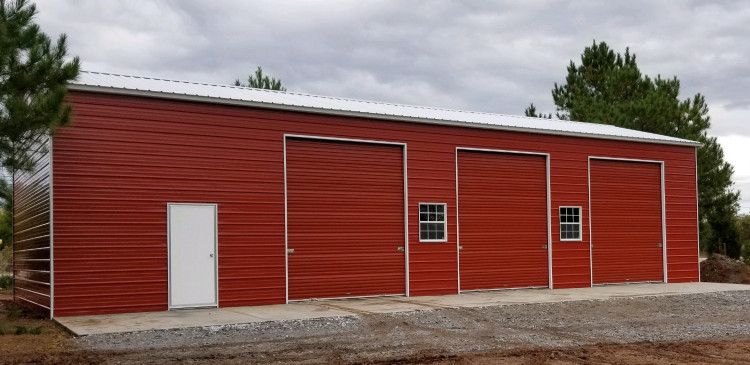
48x40x14&10 All Vertical Carolina Barn
12 & 24 & 12
30x50x12 Vertical Roof Garage
with: (3) 10'x10' Garage Doors
(1) 36"x80" Walk in Door
(2) Windows
1-877-662-9060
We sell to most of California including the following cities:
American Canyon CA, Antioch CA, Apple Valley CA, Armona CA, Arroyo Grande CA, Arvin CA, Atascadero CA, Auburn CA, Bakersfield CA, Banning CA, Barstow CA, Beaumont CA, Big Bear City CA, Big Bear Lake CA, Boyes Hot Springs CA, California City CA, Camarillo CA, Campbell CA, Canyon Lake CA, Carmichael CA, Castro Valley CA, Cathedral City CA, Ceres CA, Chico CA, Chowchilla CA, Citrus Heights CA, Clovis CA, Coachella CA, Colton CA, Colusa CA, Concord CA, Corcoran CA, Corning CA, Danville CA, Davis CA, Delano CA, Delhi CA, Dinuba CA, Dublin CA, Durham CA, Earlimart CA, Elk Grove CA, Escodidos CA, Exeter CA, Fair Oaks CA, Fairfield CA, Fallbrook CA, Farmersville CA, Fillmore CA, Firebaugh CA, Folsom CA, Fremont CA, Fresno CA, Galt CA, Gilroy CA, Glendale CA, Goleta CA, Gonzales CA, Greenacres CA, Greenfield CA, Gridley CA, Grover Beach CA, Guadalupe CA, Gustine CA, Hanford CA, Hayward CA, Hemet CA, Hesperia CA, Highland CA, Hollister CA, Indio CA, Ione CA, King City CA, Kingsburg CA, Lancaster CA, Lathrop CA, Lemore CA, Lindsay CA, Livermore CA, Livingston CA, Lockeford CA, Lodi CA, Lompoc CA, Los Alamos CA, Los Altos CA, Los Angeles CA, Los Banos CA, Los Gatos CA, Los Osos CA, Madera CA, Magalia CA, Manteca CA, Marina CA, Martinez CA, Marysville CA, McFarland CA, Mecca CA, Mendota CA, Merced CA, Milpitas CA, Modesto CA, Monterey CA, Moorpark CA, Moreno Valley CA, Morgan Hill CA, Morrow Bay CA, Murrieta CA, Napa CA, Nevada City CA, Newman CA, North Highlands CA, Novato CA, Oakdale CA, Oakland CA, Oakley CA, Oceano CA, Oildale CA, Ontario CA, Orange Cove CA, Orangevale CA, Orcutt CA, Orland CA, Oroville CA, Oxnard CA, Palermo CA, Palm Desert CA, Palm Springs CA, Palmdale CA, Paradise CA, Parlier CA, Paso Robles CA, Patterson CA, Petaluma CA, Pismo Beach CA, Pittsburg CA, Placerville CA, Planada CA, Pleasant Hill CA, Pleasanton CA, Porterville CA, Poway CA, Rancho Cordova CA, Rancho Mirage CA, Red Bluff CA, Redding CA, Redlands CA, Reedley CA, Rialto CA, Ridgecrest CA, Rio Linda CA, Rio Vista CA, Ripon CA, Riverside CA, Rocklin CA, Rohnert Park CA, Rosamond CA, Roseville CA, Sacramento CA, Salinas CA, San Bernardino CA, San Diego CA, San Francisco CA, Sanger CA, San Jose CA, San Luis Obispo CA, San Marcos CA, San Ramon CA, Santa Barbara CA, Santa Clara CA, Santa Maria CA, Santa Rosa CA, Santee CA, Seaside CA, Selma CA, Shafter CA, Simi Valley CA, Soledad CA, Solvang CA, Sonoma CA, Stockton CA, Suisun City CA, Sun City CA, Taft CA, Tehachapi CA, Temecula CA, Thermalito CA, Thousand Oaks CA, Tracy CA, Truckee CA, Tulare CA, Turlock CA, Upland CA, Vacaville CA, Vallejo CA, Ventura CA, Victorville CA, Visalia CA, Walnut Creek CA, Wasco CA, Waterford CA, Watsonville CA, Williams CA, Willows CA, Winters CA, Woodlake CA, Woodland CA, Yuba City CA, Yucaipa CA and Yucca Valley CA!
The Ultimate Guide to Pole Barns in California: Unveiling the Secrets to Building Your Perfect Structure
California, with its diverse climate and specific building regulations, presents unique challenges when it comes to constructing pole barns. Our expert tips and insights will help you navigate through these challenges, ensuring you make informed decisions every step of the way. From selecting the right materials and foundation to optimizing space utilization and enhancing the energy efficiency of your pole barn, we leave no stone unturned in providing you with the knowledge you need to build your dream structure.
Whether you're a seasoned builder or a first-time DIY enthusiast, this guide is for you. So, grab a cup of coffee, sit back, and let's embark on this exciting journey of building the perfect pole barn in California!
Constructing a pole barn in California offers numerous advantages that make it an attractive option for various applications. One of the primary benefits is the versatility of these structures. Pole barns can be designed and customized to serve a wide range of purposes, from agricultural storage and workshops to garages and even residential spaces. This flexibility allows you to tailor the building to your specific needs, ensuring that it perfectly fits your requirements.
The durability and longevity of pole barns are also noteworthy benefits. These structures are designed to withstand the unique weather conditions and environmental challenges found in California, such as high winds, heavy snowfall, and extreme temperature fluctuations. With proper maintenance and care, a well-constructed pole barn can serve you and your family or business for decades, providing a reliable and long-lasting solution to your storage, workshop, or agricultural needs.
When planning to build a pole barn in California, it's essential to carefully consider several key factors to ensure the success and longevity of your project. One of the primary considerations is the local climate and weather patterns. Arkansas is known for its diverse weather conditions, ranging from hot and humid summers to cold and snowy winters. Understanding the specific challenges posed by the local climate, such as wind loads, snow accumulation, and rainfall patterns, will help you design a pole barn that can withstand these environmental stresses.
Another crucial factor to consider is the intended use of your pole barn. Will it be used for agricultural purposes, such as storing farm equipment or housing livestock? Or will it serve as a workshop, a garage, or even a living space? Knowing the specific purpose of your pole barn will guide you in selecting the appropriate size, layout, and features to meet your needs. For instance, if you plan to use the pole barn for storing large machinery, you'll need to ensure that the structure can accommodate the necessary clearances and weight-bearing capacity.
Site selection is also a critical factor when building a pole barn in California. The location of your pole barn can have a significant impact on its functionality, accessibility, and compliance with local regulations. Consider factors such as the terrain, soil conditions, proximity to utilities, and any potential zoning or building restrictions in the area. Choosing the right location can maximize the efficiency and long-term viability of your pole barn project.
Selecting the ideal location for your pole barn in California is a crucial step in the planning process. The site you choose can have a significant impact on the overall functionality, accessibility, and compliance of your structure. When evaluating potential locations, there are several key factors to consider.
First and foremost, assess the terrain and soil conditions of the site. Pole barns require a stable and level foundation, so it's essential to choose a location with suitable soil characteristics that can support the weight of the structure. Avoid areas with poor drainage or high water tables, as these can lead to structural issues over time.
Another important consideration is the proximity to utilities. Ideally, your pole barn should be situated in close proximity to existing power, water, and sewer lines, if available. This can simplify the installation process and reduce the overall cost of the project. Additionally, consider the accessibility of the site, ensuring that it can be easily reached by vehicles and equipment necessary for the construction and ongoing use of the pole barn.
Compliance with local zoning and building regulations is also a crucial factor when selecting the location for your pole barn. Research the applicable laws and regulations in your area, as they may dictate the minimum setbacks from property lines, the maximum height or size of the structure, and any other specific requirements. Choosing a site that aligns with these regulations can help streamline the permitting process and avoid potential conflicts down the line.
Designing your perfect pole barn in California requires careful consideration of various factors to ensure that the structure meets your specific needs and complies with local regulations. One of the first steps in the design process is to determine the overall size and layout of the pole barn. Consider the intended use of the space, the amount of storage or workspace required, and any future expansion plans you may have.
When it comes to the layout, think about the flow of traffic and the placement of doors, windows, and any interior walls or partitions. Efficient use of space is crucial, so plan the design to maximize the functionality of the pole barn. If you're using the structure for agricultural purposes, such as housing livestock or storing farm equipment, you'll need to ensure that the layout accommodates the necessary clearances and access points.
The architectural style of your pole barn is another important design element to consider. While pole barns are often associated with a utilitarian aesthetic, you can incorporate design elements that complement the surrounding landscape or your personal preferences. This can include the choice of siding materials, roof styles, and even the inclusion of decorative features or accents.
Energy efficiency is also a key consideration in the design of your pole barn. Factors such as insulation, ventilation, and the placement of windows and doors can significantly impact the temperature regulation and overall energy performance of the structure. By incorporating energy-efficient design elements, you can not only reduce your operating costs but also contribute to a more sustainable and environmentally friendly building.
Welcome to the ultimate guide to pole barns in California! Whether you plan to use it for agricultural purposes, as a workshop, or even as a storage space, building the perfect pole barn requires knowledge and careful planning. In this comprehensive guide, we'll unveil the secrets to creating your ideal structure that not only meets your needs but also stands the test of time.
California, with its diverse climate and specific building regulations, presents unique challenges when it comes to constructing pole barns. Our expert tips and insights will help you navigate through these challenges, ensuring you make informed decisions every step of the way. From selecting the right materials and foundation to optimizing space utilization and enhancing the energy efficiency of your pole barn, we leave no stone unturned in providing you with the knowledge you need to build your dream structure.
Whether you're a seasoned builder or a first-time DIY enthusiast, this guide is for you. So, grab a cup of coffee, sit back, and let's embark on this exciting journey of building the perfect pole barn in California!
Benefits of building a pole barn
Constructing a pole barn in California offers numerous advantages that make it an attractive option for various applications. One of the primary benefits is the versatility of these structures. Pole barns can be designed and customized to serve a wide range of purposes, from agricultural storage and workshops to garages and even residential spaces. This flexibility allows you to tailor the building to your specific needs, ensuring that it perfectly fits your requirements.
Another significant advantage of pole barns is their cost-effectiveness. Compared to traditional stick-built structures, pole barns are generally more affordable to construct, thanks to their simpler design and the use of fewer materials. This makes them an excellent choice for those looking to maximize their budget while still obtaining a durable and functional building. Additionally, the ease of construction and the ability to perform much of the work yourself, if desired, can further reduce the overall cost of the project.
Another significant advantage of pole barns is their cost-effectiveness. Compared to traditional stick-built structures, pole barns are generally more affordable to construct, thanks to their simpler design and the use of fewer materials. This makes them an excellent choice for those looking to maximize their budget while still obtaining a durable and functional building. Additionally, the ease of construction and the ability to perform much of the work yourself, if desired, can further reduce the overall cost of the project.
The durability and longevity of pole barns are also noteworthy benefits. These structures are designed to withstand the unique weather conditions and environmental challenges found in California, such as high winds, heavy snowfall, and extreme temperature fluctuations. With proper maintenance and care, a well-constructed pole barn can serve you and your family or business for decades, providing a reliable and long-lasting solution to your storage, workshop, or agricultural needs.
Factors to consider before building a pole barn in California
When planning to build a pole barn in California, it's essential to carefully consider several key factors to ensure the success and longevity of your project. One of the primary considerations is the local climate and weather patterns. Arkansas is known for its diverse weather conditions, ranging from hot and humid summers to cold and snowy winters. Understanding the specific challenges posed by the local climate, such as wind loads, snow accumulation, and rainfall patterns, will help you design a pole barn that can withstand these environmental stresses.
Another crucial factor to consider is the intended use of your pole barn. Will it be used for agricultural purposes, such as storing farm equipment or housing livestock? Or will it serve as a workshop, a garage, or even a living space? Knowing the specific purpose of your pole barn will guide you in selecting the appropriate size, layout, and features to meet your needs. For instance, if you plan to use the pole barn for storing large machinery, you'll need to ensure that the structure can accommodate the necessary clearances and weight-bearing capacity.
Site selection is also a critical factor when building a pole barn in California. The location of your pole barn can have a significant impact on its functionality, accessibility, and compliance with local regulations. Consider factors such as the terrain, soil conditions, proximity to utilities, and any potential zoning or building restrictions in the area. Choosing the right location can maximize the efficiency and long-term viability of your pole barn project.
The Advantages of California Metal Pole Barns: A Complete Guide
When it comes to durable, cost-effective, and versatile structures, metal pole barns from California stand out as a top choice. From agricultural purposes to commercial and residential use, the advantages of metal pole barns are vast and varied. In this complete guide, we'll delve into the myriad benefits these structures offer, from their customizable designs to their energy efficiency and low maintenance requirements.
The sturdy construction of California metal pole barns provides optimal protection against the elements, ensuring long-term reliability and resilience. Additionally, their open-span design allows for spacious interiors without the need for intrusive support beams. This feature makes them ideal for accommodating a wide range of activities and storage needs.
Whether you're considering a new building project or contemplating upgrading an existing structure, understanding the advantages of metal pole barns is essential for informed decision-making. Join us as we explore everything you need to know about these versatile and dependable constructions.
Understanding metal pole barns from California
Metal pole barns from California, also known as post-frame buildings, are constructed using large poles or posts buried in the ground or secured to a concrete foundation. These sturdy poles support the roof and walls, creating a durable and reliable structure. The open-span design of metal pole barns eliminates the need for interior support walls or columns, providing a spacious and versatile interior space.
Metal pole barns can be customized to suit a wide range of needs, from agricultural storage and equestrian facilities to workshops, retail spaces, and residential housing. Their versatility and cost-effectiveness make them a popular choice for various applications.
Metal pole barns are distinguished by their simple yet effective construction, which prioritizes functionality and durability. This straightforward building method contributes to their affordability and ease of construction, making them an attractive option for many property owners.
Choosing the right location for your pole barn
Selecting the ideal location for your pole barn in California is a crucial step in the planning process. The site you choose can have a significant impact on the overall functionality, accessibility, and compliance of your structure. When evaluating potential locations, there are several key factors to consider.
First and foremost, assess the terrain and soil conditions of the site. Pole barns require a stable and level foundation, so it's essential to choose a location with suitable soil characteristics that can support the weight of the structure. Avoid areas with poor drainage or high water tables, as these can lead to structural issues over time.
Another important consideration is the proximity to utilities. Ideally, your pole barn should be situated in close proximity to existing power, water, and sewer lines, if available. This can simplify the installation process and reduce the overall cost of the project. Additionally, consider the accessibility of the site, ensuring that it can be easily reached by vehicles and equipment necessary for the construction and ongoing use of the pole barn.
Compliance with local zoning and building regulations is also a crucial factor when selecting the location for your pole barn. Research the applicable laws and regulations in your area, as they may dictate the minimum setbacks from property lines, the maximum height or size of the structure, and any other specific requirements. Choosing a site that aligns with these regulations can help streamline the permitting process and avoid potential conflicts down the line.
Designing your perfect pole barn
Designing your perfect pole barn in California requires careful consideration of various factors to ensure that the structure meets your specific needs and complies with local regulations. One of the first steps in the design process is to determine the overall size and layout of the pole barn. Consider the intended use of the space, the amount of storage or workspace required, and any future expansion plans you may have.
When it comes to the layout, think about the flow of traffic and the placement of doors, windows, and any interior walls or partitions. Efficient use of space is crucial, so plan the design to maximize the functionality of the pole barn. If you're using the structure for agricultural purposes, such as housing livestock or storing farm equipment, you'll need to ensure that the layout accommodates the necessary clearances and access points.
The architectural style of your pole barn is another important design element to consider. While pole barns are often associated with a utilitarian aesthetic, you can incorporate design elements that complement the surrounding landscape or your personal preferences. This can include the choice of siding materials, roof styles, and even the inclusion of decorative features or accents.
Energy efficiency is also a key consideration in the design of your pole barn. Factors such as insulation, ventilation, and the placement of windows and doors can significantly impact the temperature regulation and overall energy performance of the structure. By incorporating energy-efficient design elements, you can not only reduce your operating costs but also contribute to a more sustainable and environmentally friendly building.

